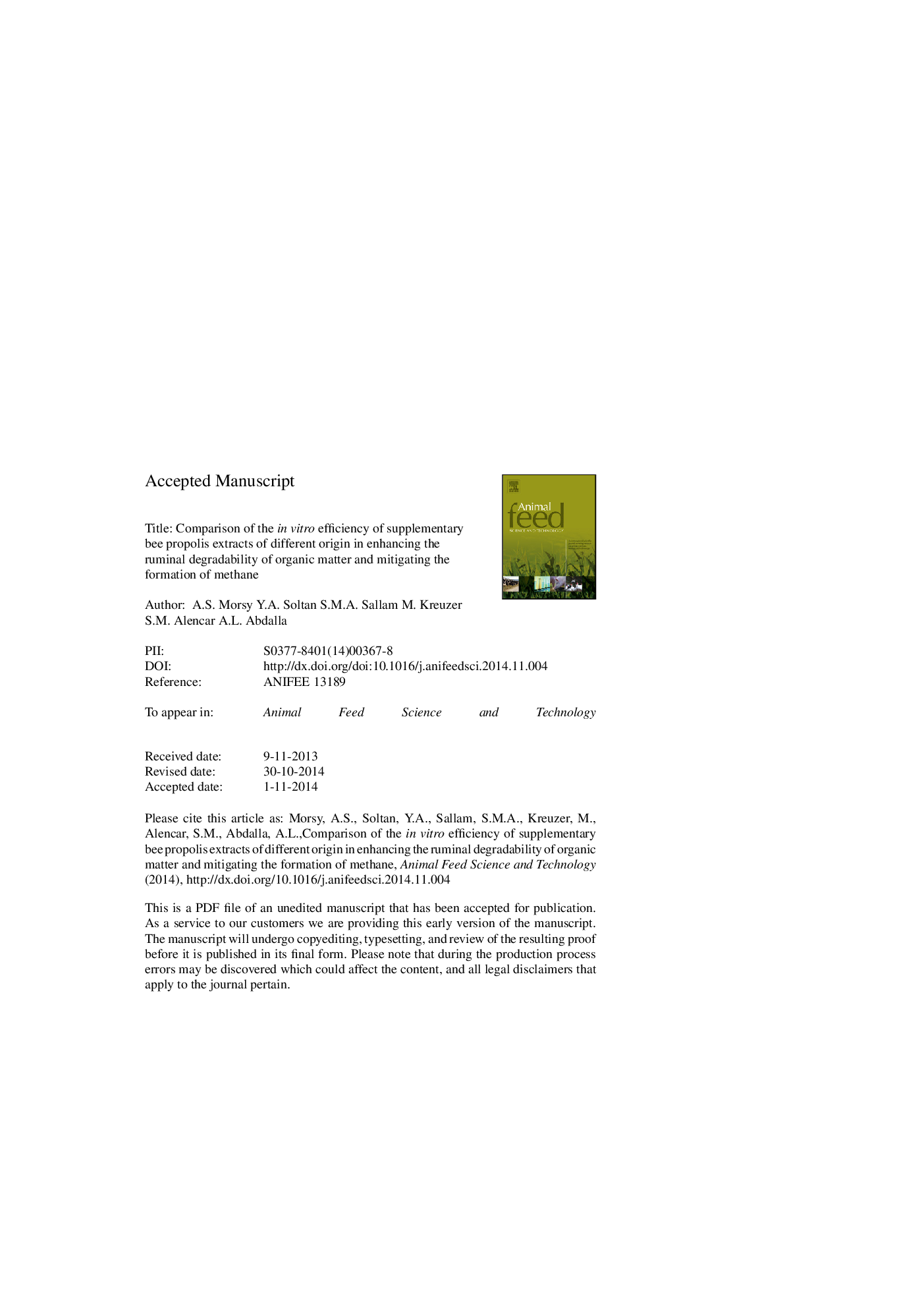| کد مقاله | کد نشریه | سال انتشار | مقاله انگلیسی | نسخه تمام متن |
|---|---|---|---|---|
| 8491422 | 1552386 | 2015 | 34 صفحه PDF | دانلود رایگان |
عنوان انگلیسی مقاله ISI
Comparison of the in vitro efficiency of supplementary bee propolis extracts of different origin in enhancing the ruminal degradability of organic matter and mitigating the formation of methane
ترجمه فارسی عنوان
مقایسه کارایی درونی عصاره مکمل عصاره زنبور عسل مشتقات مختلف در افزایش شکستگی شکم مواد آلی و کاهش تشکیل متان
دانلود مقاله + سفارش ترجمه
دانلود مقاله ISI انگلیسی
رایگان برای ایرانیان
کلمات کلیدی
ADFomTDOMlignin determined by solubilization of cellulose with sulfuric acidaNDFomCH4BRPEBPSCFAGC–MS - GC-MSShort-chain fatty acids - اسیدهای چرب کوتاه مدتFeed additive - افزودنی خوراکash-free acid detergent fiber - الیاف پاک کننده اسید اسید آزادRuminal fermentation - تخمیر شفافGas production - تولید گازgas chromatography–mass spectrometry - طیف سنجی جرم کروماتوگرافی گازether extract - عصاره اترpartitioning factor - فاکتور پارتیشن بندیBatch culture - فرهنگ دسته ایLignin(sa) - لیگنین (در)organic matter - ماده آلیdry matter - ماده خشکMethane - متان Brazilian red propolis - مرجان قرمز برزیلیMonensin - موننسینcrude protein - پروتئین خامpropolis - پرپولیس یا برهموم
موضوعات مرتبط
علوم زیستی و بیوفناوری
علوم کشاورزی و بیولوژیک
علوم دامی و جانورشناسی
چکیده انگلیسی
The current study was conducted to compare the effects of ethanolic extracts of Brazilian red propolis (BRP) and Egyptian brown propolis (EBP) characterized by different individual compounds on the ruminal degradation of nutrients and methanogenesis. The utility of propolis as a natural alternative to the ionophore antibiotic monensin, which was used as a positive control, was also tested. The propolis extract was incubated with 0 (negative control), 125, 250, or 500 μg per 500 mg of dietary dry matter. A semi-automatic in vitro gas production (GP) system was operated with three batches of rumen fluid in three replicates per batch for each treatment. The major compounds of the BRP extract were isoflavonoids and chalcones, which represented 0.43 of the total. Isoflavonoids and saturated fatty acids made up 0.53 of the EBP extract. Extract of BRP25 μg enhanced the true organic matter degradability (TDOM) (P<0.05) compared with negative control. All doses of BRP and EBP25 μg enhanced (P<0.05) TDOM compared with monensin while no differences were observed among the propolis extract treatments. Compared with the negative control, the treatment suppressing (P<0.05) methane (CH4) and total GP was monensin. The propolis extracts were only half or less than half as effective as monensin against CH4 production. Both the BRP and EBP extracts increased (P<0.05) the production of total and all major (acetate, propionate, butyrate) short-chain fatty acids (SCFA). Monensin enhanced (P<0.05) only propionate production, clearly reduced (P<0.05) the acetate-to-propionate ratio compared with the negative control. Ruminal ammonia remained unaffected by the treatments, but the propolis extracts reduced (P<0.05) the protozoal count. This study demonstrated the efficiency of two types of propolis extracts, although they were less effective than monensin in mitigating CH4 emissions. It also showed that propolis with very different compositions seemed to act in a similar way and that the efficiency of the two types of propolis in modifying the ruminal degradation of nutrients and mitigating methane formation was comparable. The most active component(s) in propolis still have to be identified.
ناشر
Database: Elsevier - ScienceDirect (ساینس دایرکت)
Journal: Animal Feed Science and Technology - Volume 199, January 2015, Pages 51-60
Journal: Animal Feed Science and Technology - Volume 199, January 2015, Pages 51-60
نویسندگان
A.S. Morsy, Y.A. Soltan, S.M.A. Sallam, M. Kreuzer, S.M. Alencar, A.L. Abdalla,
